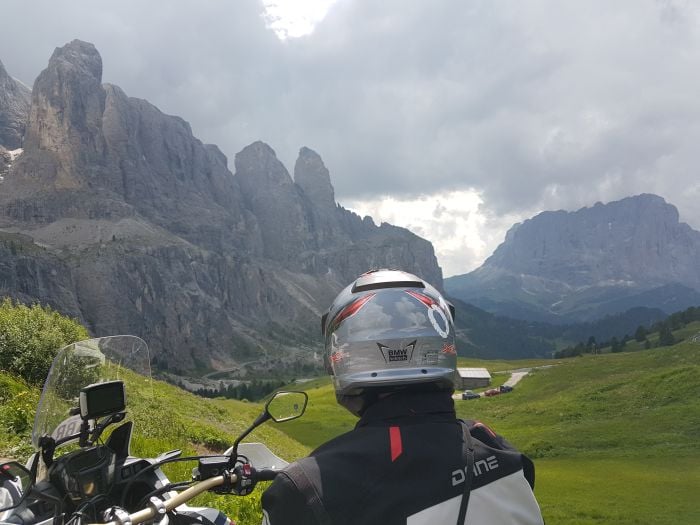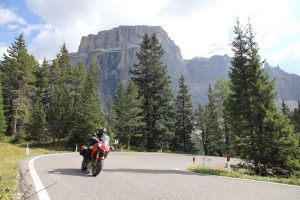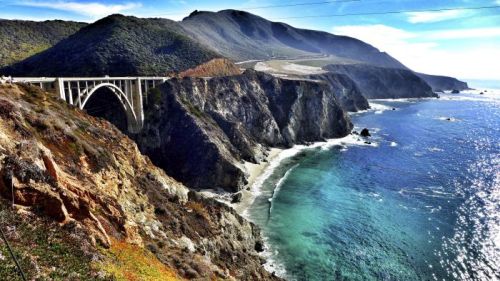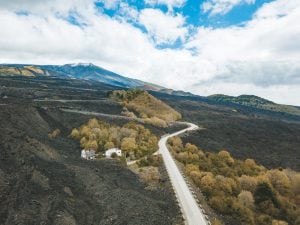I held my right hand in front of my face to check if the bolognese I’d eaten the night before might’ve caused me to hallucinate. I’d not had the pleasure of seeing the massive rock spires of the Dolomites in person before, only viewing them through a computer screen as I obsessed over their uncompromising natural beauty.
I turned off the KTM and took another look at the huge wall rising from the roadside in front of me. It was Cimon della Pala, the Matterhorn of the Dolomites, and it was views like this that had drawn us to the Italian UNESCO World Heritage Site on our summer tour around Europe
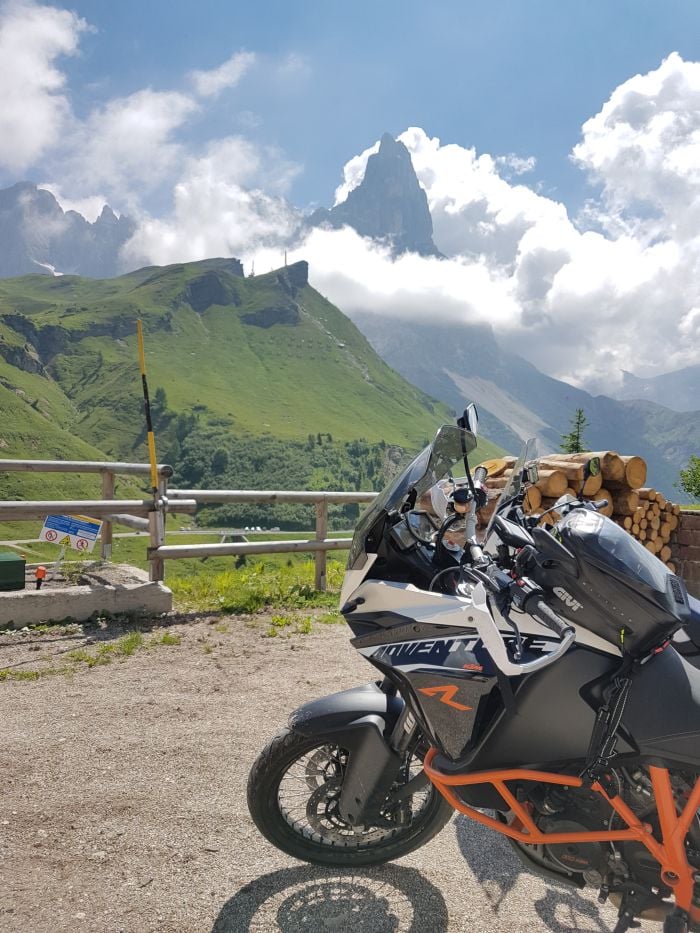
Bryn’s KTM and Cimon della Pala as seen from Passo Rolle
Every year we head over to Friedrichshafen in Germany for an industry show, and on the way we make a point of expanding the trip to explore a little more of the Alps. Three years ago we almost got stranded high up on the military roads of the Maritime Alps when the chain snapped on our Ténéré, and the clutch burnt out on our V-Strom as a result of towing said Ténéré.
Last year we rode what can only be described as some of the most visually stunning balcony roads in Europe as we explored the Vercors, and this year we thought we’d head east, to an area of the Alps that I’d fantasised about visiting since I was a young lad, the Dolomites.
For the last hundred years climbers from around the world have flocked to the Dolomites like pilgrims to the shrine. The impressive rock faces might provide the perfect backdrop for a grand motorcycle tour of the Italian Alps, but for more, how can I put this, daring individuals, the desire to scale these peaks is as alluring as a GS with a favourable finance deal.
Spend an hour talking to the publisher of ABR, Alun, about his climbing exploits in this region and you’ll be treated to many stories from his younger years which were spent climbing the huge limestone walls that I now sat under.
He was even made a Freeman of Trentino for his service in documenting the vast network of via ferrata routes that take thrill-seeking hikers across exposed cliff faces, with nothing but a wire rope (a fortunately strong one) and a harness to keep them from plummeting into the valleys below.
The beauty of riding mountain passes in the Dolomites
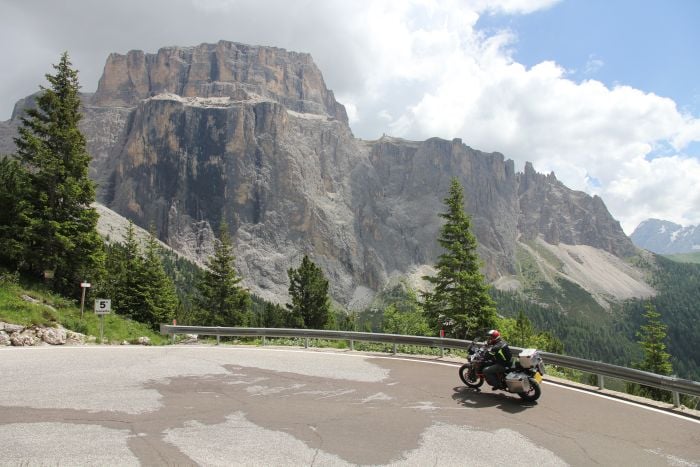 We had only planned to spend a few days of our 11-day tour in the Italian mountain range, but what we hadn’t accounted for was the fact that when you enter the Dolomites it’s akin to riding into a Bermuda Triangle-like Nirvana, and it’s hard to leave.
We had only planned to spend a few days of our 11-day tour in the Italian mountain range, but what we hadn’t accounted for was the fact that when you enter the Dolomites it’s akin to riding into a Bermuda Triangle-like Nirvana, and it’s hard to leave.
The serpentine roads twist and turn their way through this magnificent area and over each crest of a pass is a new view that, although not too dissimilar from the last, will have you pulling over in admiration time and time again. And so, by the end of our trip, we ended up spending the majority of our time exploring Italy’s natural gift to the world, riding as many passes as we could.
We also made it our aim to seek out the lesser known passes of the area, those that offer a real sense of adventure while still being achievable to the average rider with little to no off-road experience.
There were three roads that really impressed, three roads that would excite even the most experienced adventure rider, and three roads that we could find very little about when searching the fountain of knowledge that is the internet: Forcella Lavardet, Passo della Forcella, and the Lusia Pass.
Forcella Lavardet (SS465)
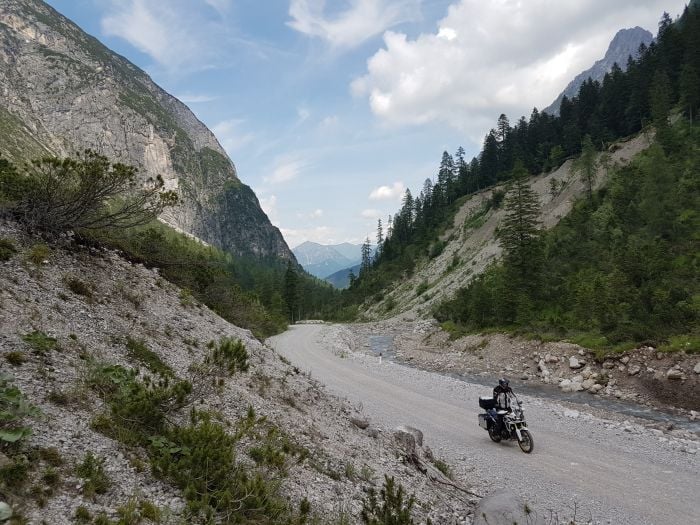 There’s something about abandoned places that gets me going. I can’t quite put my finger on it, but I’m pretty sure it lies somewhere between letting my imagination run wild, picturing what the place would have looked like in times of old, and my somewhat childlike mind conjuring up images of how the world might look like after a zombie apocalypse.
There’s something about abandoned places that gets me going. I can’t quite put my finger on it, but I’m pretty sure it lies somewhere between letting my imagination run wild, picturing what the place would have looked like in times of old, and my somewhat childlike mind conjuring up images of how the world might look like after a zombie apocalypse.
Forcella Lavardet is a mountain pass that combines these feelings with an epic ride along a part tarmacked, part gravel track. The pass is, as most old passes are, a disused military road, and in years gone by it would have seen its fair share of traffic.
At some point in its more recent history, I’ve been unable to find the exact date, one of the bridges that the road travels over was washed out during a particularly heavy rainstorm, and landslides decimated most of the road.
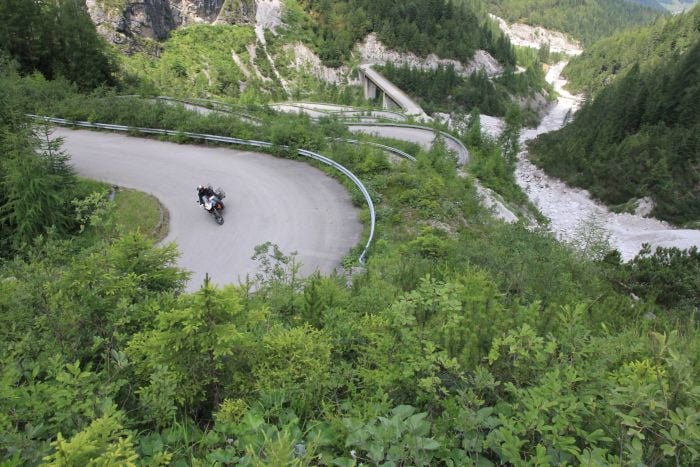 Renovations to the pass have been ongoing since the event, though when you take a ride up Forcella Lavardet you get the impression that they’re practising the British method of road maintenance, that is, doing sweet nothing. As such, technically the road is closed, though we passed a handful of cars and motorcyclists on our climb, none of which seemed particularly concerned with the status of the pass.
Renovations to the pass have been ongoing since the event, though when you take a ride up Forcella Lavardet you get the impression that they’re practising the British method of road maintenance, that is, doing sweet nothing. As such, technically the road is closed, though we passed a handful of cars and motorcyclists on our climb, none of which seemed particularly concerned with the status of the pass.
More to the point, we could see no reasons for the closure, the new bridge is passable, the road, while mostly a gravel track, is easy going and the tarmacked bits are certainly ridable.
Forcella Lavardet can be reached by turning south out of the small town of Campolongo, and heading up what looks like a gravel access track. The deeper you go the more it feels like you’re heading into the wilderness, the track gets more ‘gravely’ and the valley seems more remote.
Despite the very mention of a gravel track striking fear into the hearts of some who have never ridden off-road before, big adventure bikes will have no problem riding this route. We were on a KTM 1190 and an Africa Twin, both of which groaned under the weight of our equipment and personal body masses, and the going was nice and easy.
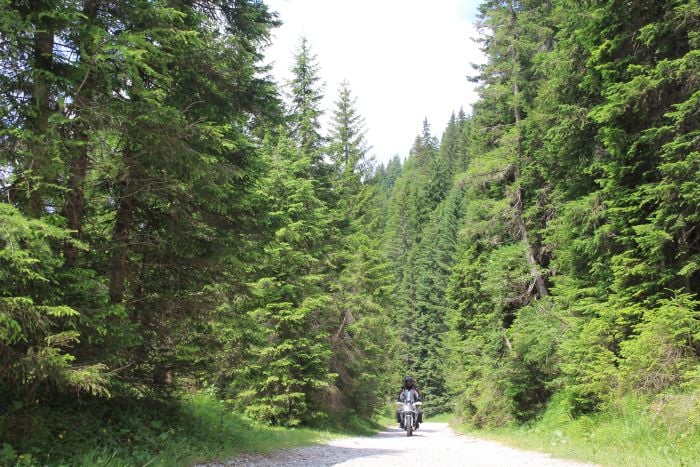 The riding is, for the most part, a delight. Don’t make the mistake of thinking that Forcella Lavardet is a road that can be ridden fast, the surface won’t allow it, and to do so would mean to not savour the act of riding through such an incredible part of this fine planet of ours.
The riding is, for the most part, a delight. Don’t make the mistake of thinking that Forcella Lavardet is a road that can be ridden fast, the surface won’t allow it, and to do so would mean to not savour the act of riding through such an incredible part of this fine planet of ours.
After two and a half miles the gravel merges with an old tarmac road and you get your first glimpse of a series of 14 switchbacks that climb their way up the side of the mountain in front of you like rungs of a giant ladder.
Take your time to savour the climb, but be wary on the hairpins as over time gravel has accumulated in areas, making for some unnerving slides if caught at the wrong angle.
Once you reach the top you can look down at the mighty serpent that you just conquered, continuing the ride past a tiny chapel and along a river. Before the route ends the dirt track takes you through a delightful wooded area where, if you turn the engine off, you can experience the deafening sound of silence.
Forcella Lavardet will deposit you on the SP619 road between Comeglians and Laggio di Cadore, head to the latter and you’ll be on course to ride the next hidden gem: Passo della Forcella.
Getting to Forcella Lavardet
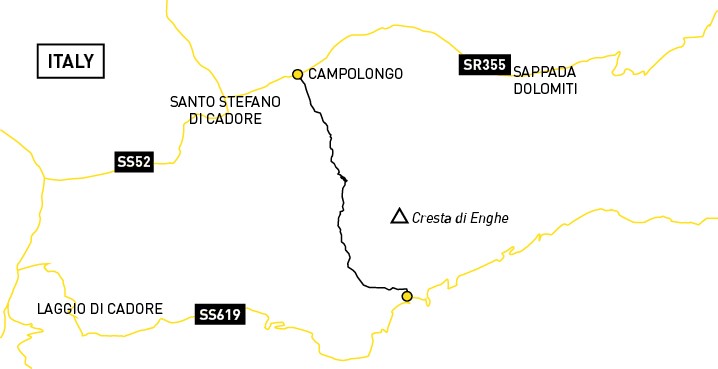
Forcella Lavardet is easily reachable no matter which direction you plan to tackle it. From the north, you’ll need to navigate to Campolongo.
Once in the small Italian town seek out Strada Statale 465, the road which will eventually begin its climb as Forcella Lavardet. About a mile in you’ll come to a fork in the road where you’ll see signs about the state of the pass, stick to the left here and you’re golden.
Approaching from the south, navigate to Comeglians and ride down the SR355 until, after a short distance, you’ll turn right over a bridge that spans Torrente Degano. Continue on this mountain road for 13 miles, enjoying the ride as you go, before you reach a nondescript gravel access road on your right hand side. That’s Forcella Lavardet.
Passo della Forcella
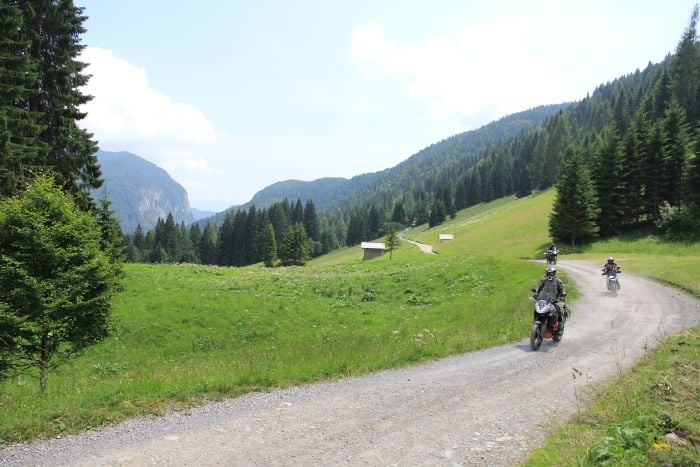 For a real sense of isolation and awe inspiring views, Passo della Forcella is surely one of the Dolomites’ best motorable passes.
For a real sense of isolation and awe inspiring views, Passo della Forcella is surely one of the Dolomites’ best motorable passes.
Dirt track on one side, tarmac on the other, the pass links up the two small villages of Lateis and Mione in the commune of Udine. It’s hard to find much information about the road, with any online searches only returning results in German or Italian, but having ridden it it appears to be an access track for a lonely farm that lies near the crest of the pass.
We began the route in Lateis, just a few miles north of Lago di Sauris, from the Albergo Ristorante Riglarhaus, the last place you’ll be able to get a drink and some food from before you tackle the pass. It’s also an opportunity to gather some intel from the locals about the state of the road, though English is not widely spoken in the village.
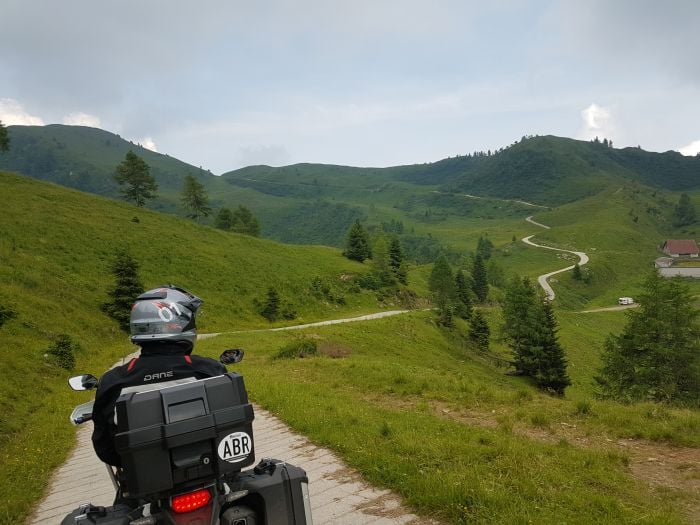 Fortunately for us a group of international journalists turned up as we were eating gnocchi and drinking hemp beer, which is apparently a local speciality. The leader of the journalists, who spoke impeccable English, warned us that Passo della Forcella was unlikely to be motorable due to poor conditions and a lack of maintenance. We thanked her but decided to see for ourselves.
Fortunately for us a group of international journalists turned up as we were eating gnocchi and drinking hemp beer, which is apparently a local speciality. The leader of the journalists, who spoke impeccable English, warned us that Passo della Forcella was unlikely to be motorable due to poor conditions and a lack of maintenance. We thanked her but decided to see for ourselves.
As you climb out of the village you soon hit the gravel as the track takes you through a heavily forested area. To your right there will be almost sheer drops into the trees below, keep your calm and you’ll have no problem.
Throughout the duration of the ride you’ll come across concrete drainage channels that span the width of the track. A restrained riding style is required when negotiating these as the trenches can be quite deep and can bottom your bike out.
For a few miles the track continues in this style, climbing through trees followed by open meadows or trails that have been cut out from the slopes of the mountain. As you get higher and higher the views become even more spectacular, but keep your eyes on the road as the drop to the right gets bigger and bigger.
You really get a sense of being ‘out there’ as you ride Passo della Forcella, and you’ll be afforded beautiful views over the near uninhabited valleys below, far away from the convoys of tourists sticking to the main passes.
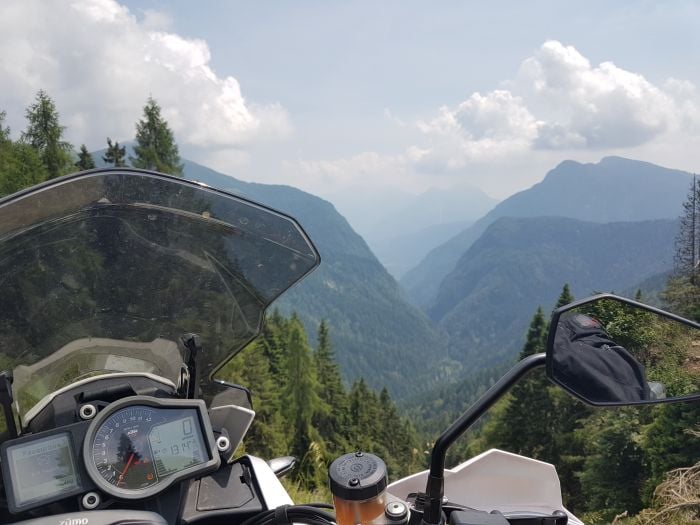
Once you’ve reached the crest of the pass the panorama is worth the trip alone. Take some time to soak it all in, and then prepare yourself for the descent into Ovaro via the devilishly steep, though tarmacked road.
If you’re worried about your breaks burning out, you probably shouldn’t be up here, because a series of switchbacks take you down the side of the valley for a few miles, all the while maintaining a 28% incline. We didn’t pass a single car coming down this way, but caution should still be taken, of course.
After a few miles, you’ll pass through the small village of Mione, there’s nothing to see here other than the calm, peaceful way of life, so continue down to Ovaro where you can grab a drink and recount the epic pass you’ve just ridden. In total, this road took us about an hour and 20 minutes to ride, and during that time we didn’t come across a single person or car. It was heavenly.
Getting to Passo della Forcella
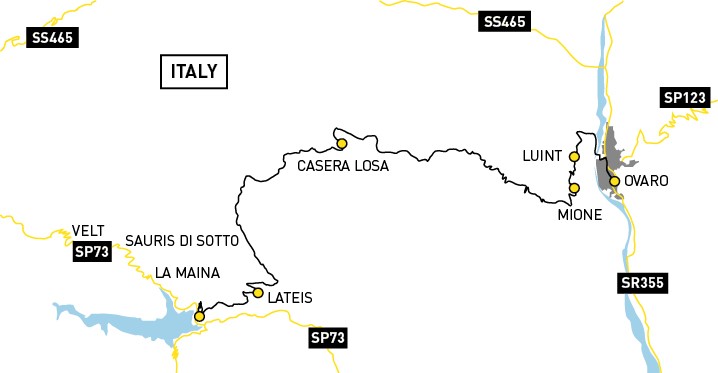
If you ride Forcella Lavardet first, it’s just a 14-mile ride to the start of Passo della Forcella.
The start of the pass can be found just outside the small village of Lateis, which is a few minutes north of the serene Lago di Sauris. Lateis is a good place to stop for a bite to eat and drink before you tackle the pass.
Lusia Pass
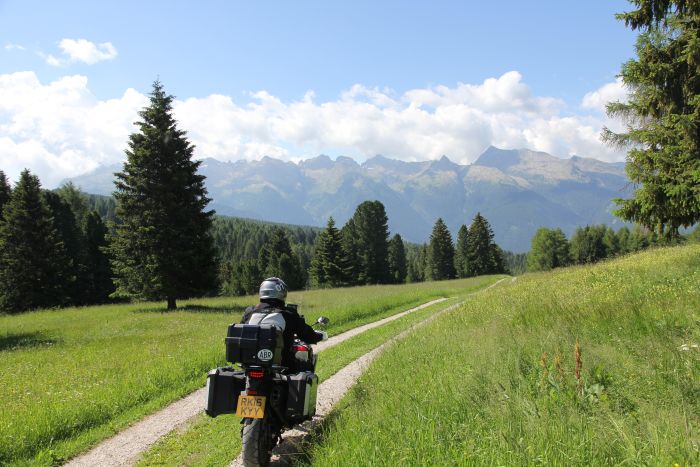 On one of our first nights in the Dolomites we found ourselves checking into Hotel Faloria in Moena, a charming village in the Fassa Valley that’s bisected by the River Avisio.
On one of our first nights in the Dolomites we found ourselves checking into Hotel Faloria in Moena, a charming village in the Fassa Valley that’s bisected by the River Avisio.
Moena has a rich and intriguing history that’s been heavily influenced by Ottoman traditions. As the story goes, in 1683 during the Ottoman Empire’s campaign to conquer Vienna, an Ottoman Janissarie, an elite soldier, called Hasan, fled from the siege of Vienna after being sentenced to death for berating his superior. He travelled for over 100 miles by foot, tired and weary from battle, until he stumbled upon the small Italian village of Moena. The locals here offered him sanctuary and tended to his wounds.
After Hasan had rejuvenated, he decided to stay in the village and ended up marrying a local. The Janissarie then led a revolt against the Duchy of Augsburg who demanded high taxes from the villagers.
The revolt was successful, and since then Hasan has been celebrated as the town’s hero. Remembering the town’s history, every year in the first week of August, the Moena Turkish Festival is held, where the villagers dress up in Ottoman janissary costumes, hang Ottoman flags, and name the eldest villager the ‘Sultan’.
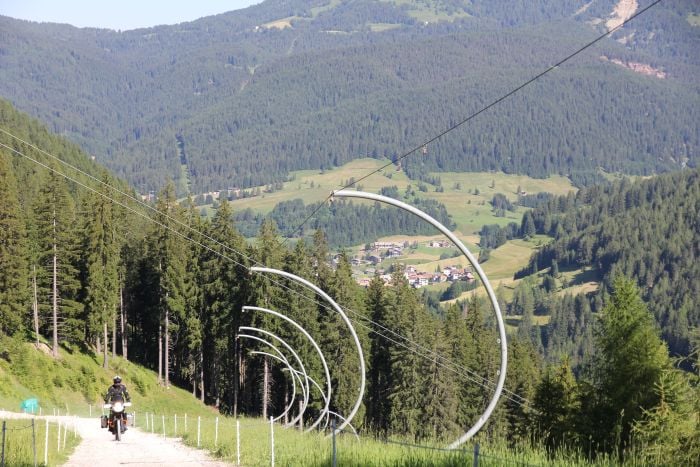 We first heard about the road when searching for trails to ride around Moena. As most of the off-road routes around the Dolomites are off limits, unless you get permission from the area’s mayor, we were uncertain of whether the Lusia Pass would be legal, so we set out to seek the knowledge of the locals.
We first heard about the road when searching for trails to ride around Moena. As most of the off-road routes around the Dolomites are off limits, unless you get permission from the area’s mayor, we were uncertain of whether the Lusia Pass would be legal, so we set out to seek the knowledge of the locals.
The first person we asked, our waiter at breakfast, told us it was a no-go, though he wasn’t 100% sure. The second person we asked replied with genuine enthusiasm “oh you must ride it! We used to have a chalet up there and my brother used to ride his motorcycle up there all the time! Of course, it’s legal.” And so, we set off, looking for the entrance to the pass.
The entrance is found opposite the Lusia ski lift, and on first inspection it simply looks like a gravel access track. The trail quickly ascends and soon you’re riding through a lush, green meadow, with the ski lift crossing overhead. From the meadow, the trail enters a forested area, where a series of bends flanked by steep drops raise the excitement levels. Every now and then you catch a glimpse of the magnificent, jagged stone walls that the Dolomites are so famous for.
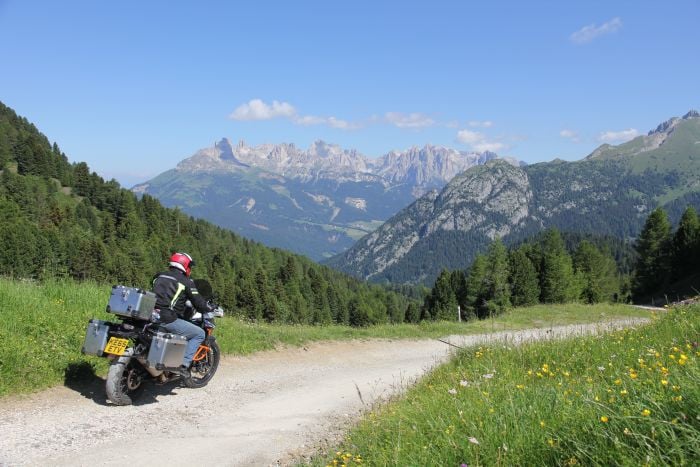 For the most part, the going on the trail is easy, with there only being a few sections of loose gravel and a couple of steep hairpins. Aside from that you should have no problem ascending to the Lusia Refuge at the crest of the pass (2,000m), where you can grab a bite to eat and a cup of coffee.
For the most part, the going on the trail is easy, with there only being a few sections of loose gravel and a couple of steep hairpins. Aside from that you should have no problem ascending to the Lusia Refuge at the crest of the pass (2,000m), where you can grab a bite to eat and a cup of coffee.
The descent down the southern side of the pass is a bit tastier, with the slopes being steeper and the gravel being looser. You’ll pass multiple ski lifts as you ride down, and keep your wits about you as this southern side had a lot more cars on it than the northern flank.
Getting to the Lusia Pass
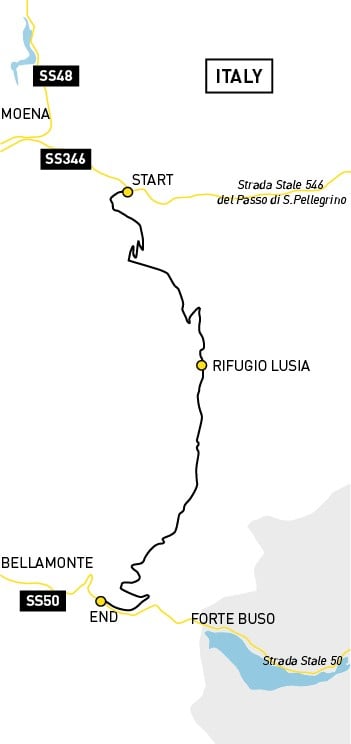
The Lusia Pass is easily found if you use Moena as your starting point. Simply travel two miles east of the village, along the SS346 and you’ll find the start of the track opposite the Lusia ski lift. Simples.


